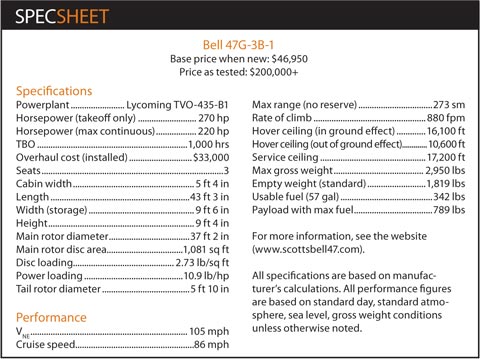Bell 47 Helicopter: Movie and TV star
The Bell 47 is as hard-working as seen on screen
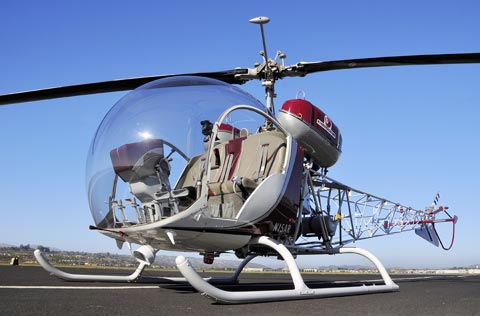
Photography by Skip Robinson
Anyone who has ever seen M*A*S*H (the 1970 feature film or the subsequent television series) will instantly recognize one of the stars, a Bell 47 helicopter. The distinctive bug-eyed aircraft with the skeletal-framework fuselage and uncowled engine also was a central character in the television series, Whirlybirds (1957-1960).
The Bell 47 was designed by Arthur M. Young, a Princeton graduate who convinced Bell Aircraft a month before the attack on Pearl Harbor to sponsor him in building a full-size version of his Model 30 helicopter. This made possible its first untethered flight in June 1943. In March 1946 a third version of Young’s helicopter, the Bell 47, became the first helicopter certified by the Civil Aeronautics Administration.
It was difficult for some fixed-wing pilots of that era to accept the notion that rotor blades served the dual purpose of providing both thrust and lift. They said that a helicopter had “no visible means of support.” Some claimed that helicopters could fly only by “beating the air into submission.” Others said that they looked as though they were “trying to thrash themselves to death.”
A lot of firsts
At the beginning of the Korean War, wounded soldiers were transported by ground to the nearest Mobile Army Surgical Hospital (MASH), a trip that could take 10 to 20 hours. Many of them died before getting there. Travel time was slashed at the end of 1950 when Bell 47s, fitted with a cocoon-like stretcher pod on each landing skid, began serving as medevac helicopters. Soldiers taken down by enemy bullets or shrapnel could arrive at MASH units in these “angels of mercy” within an hour of being hit.
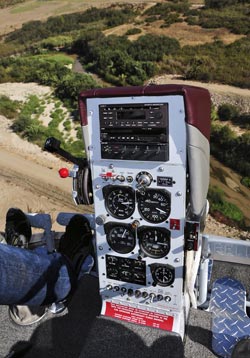 The aircraft used in the award-winning M*A*S*H television series was a Bell H-13 Sioux, the U.S. Army equivalent of the Bell 47D-1.
The aircraft used in the award-winning M*A*S*H television series was a Bell H-13 Sioux, the U.S. Army equivalent of the Bell 47D-1.
Being the first certified helicopter, the utilitarian Bell 47 chalked up a wide variety of firsts. It was the first helicopter to carry a president, first to land on the White House lawn, first to become a gunship, first to deliver mail, first to be used as a camera platform, first to become a crop sprayer, first to fly over the Swiss Alps—the list is endless. It also, of course, was the first helicopter to become a television star. NASA used Bell 47s to help train astronauts for the Apollo Lunar Module (the moon lander).
Not all Bell 47s look alike, however. That is because every piston-powered helicopter made by Bell was called a Model 47. Although most were characterized by the bubble canopy and skeletal framework, many of the more than 5,600 helicopters built during a production run of 28 years varied substantially in appearance. The Bell 47B, for example, had an enclosed fuselage and four-wheel landing gear. The final iteration, the Bell 47J Ranger, appeared similar to its well-known turbine-powered successor, the Bell 206 JetRanger, which was introduced in 1966. Bell Helicopter produced 24 civilian and 23 military variants of the Model 47. The most popular of the series was the Model 47G; more than 3,000 were sold in more than 40 countries.
N15AR
The helicopter shown here, N15AR, is a Bell 47G-3B-1 that made its first flight on April 5, 1963. Comparing it to original Bell 47s, it has a bench seat that accommodates three instead of two and metal rotor blades instead of wooden ones. It left the factory with a vertically mounted, turbocharged, 270-horsepower Lycoming TVO-435 engine instead of the 178-horsepower Franklin engine found in early Model 47s.
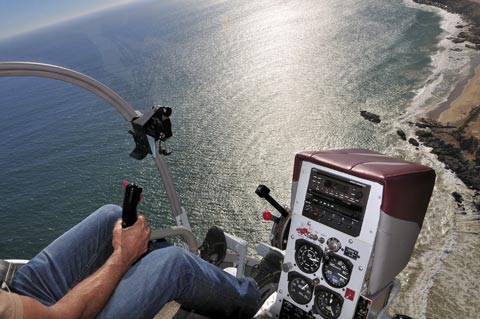
N15AR began its career as a police helicopter in Canada (CF-PDX), returned to the United States in 1980, and eventually was modified and meticulously restored. Modifications included lowering the instrument pedestal and moving the battery aft from in front of the pedestal and out of the cockpit to a point next to the engine, making it more difficult for pilots to violate the narrow 5.5-inch center-of-gravity envelope. The original skids were replaced with those from a Bell JetRanger, the turbocharger was removed, and high-domed pistons were incorporated to increase compression.
Incidentally, several models of the Bell 47 can be converted to turbine power using a supplemental type certificate developed by Soloy Aviation Solutions. An Allison 250 (now known as the Rolls-Royce M250) turboshaft engine replaces the Lycoming powerplant.
N15AR was purchased by Jim Magglos, a restaurateur who owned Baja Fresh Mexican Grill, a fast-food chain that he began in 1990 and sold to Wendy’s International in 2002. He had been bitten by the flying bug and developed affection for the Bell 47 when he took a scenic flight in one in San Pedro, California, during the early 1970s. In addition to the Bell 47G-3B-1, Magglos also has a turbine-powered Bell 206L-1 II LongRanger and half-interest in a Hughes 500C and a Cessna 320 Skyknight. His 1,200 hours are equally divided between fixed- and rotary-wing aircraft.
Because he spends so much time at his home airport in Camarillo, California, and because the restaurant business seems to run in his blood, he decided that it would be fun to combine his interests and operate an airport eatery. “Besides,” he says, “I needed a place to hang out.” In 2008 he purchased the Waypoint Café and completely remodeled it. The restaurant includes a large outdoor patio overlooking the transient tiedown area and has become one of Southern California’s more popular fly-in destinations.
Magglos kindly arranged for his friend, Ken Obi, to provide me with a few hours of refresher instruction in preparation for this article. Obi emigrated from Japan to the United States when he was a young man wanting to become a cowboy. After working on a ranch he eventually discovered that he’d rather sit in the instructor’s seat of a helicopter than in the saddle. He now owns Orbic Helicopters, a maintenance facility, flight school, and Robinson Helicopters dealer at the Camarillo Airport.
Back in the saddle
It has been 47 years since I obtained my helicopter ratings and did some instructing in a Bell 47D-1 in Long Beach, California. “Rusty” did not begin to describe my lack of proficiency.
Just climbing into the aircraft and buckling into N15AR triggered a flood of memories of flying helicopters in my previous life. Visibility from the bubble canopy is as incredible as I remembered.
I reacquainted myself with the controls and mentally reviewed the principles of helicopter operation. My left hand fell nicely onto the collective, a handle adjacent to my left thigh that, when raised, collectively (simultaneously) increases the pitch angles of both rotor blades. The throttle is at the forward end of the collective and is twisted like the throttle on a motorcycle to increase and decrease power. My right hand reached for the cyclic, which is like the control stick of an airplane. Moving it left or right tilts the rotor disk left or right, thus causing the helicopter to bank in the desired direction. Moving the stick forward tilts the rotor disk forward, thus increasing forward thrust and speed. This also causes the nose to pitch down. The reverse occurs when moving the stick aft.
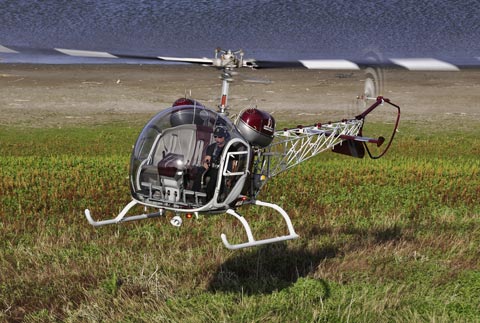
Although they resemble rudder pedals and control yaw, the two foot pedals are really anti-torque pedals. Because the main rotor blades move counterclockwise (when viewed from above), the resulting torque wants to yaw the helicopter in the opposite direction, or to the right. The tail rotor prevents this by generating thrust to the right. This produces a left yawing moment that offsets main-rotor torque. Were it not this way, it would be impossible to maintain a constant heading in a single-rotor helicopter in powered flight. The greater the torque generated by the main rotor, the more the pilot must pressure the left rudder pedal to increase the anti-torque force, and vice versa.
The Lycoming engine is started the same way in which you would do it in an airplane. As soon as it starts, however, a centrifugal clutch automatically engages and accelerates the main rotor and tail rotor. Reduction gearing maintains main-rotor rpm at one-ninth of engine rpm. Preflight warm-up and runup is conventional except for checking to ensure that the rotor clutch will automatically disengage in the event of engine failure. With the engine at 1,500 rpm (rotor at 167 rpm), quickly twist the throttle closed. The rotor should continue to spin in freewheeling fashion without the rapid slowing that would otherwise occur if the clutch failed to disengage. Engine rpm is restored with the throttle, and this reengages the clutch so that rotor and engine rpm are once again “matched.”
Then came the moment of truth. Would I be able to lift the 47 into a hover without making a fool of myself? After increasing power to a rotor speed of almost 370 rpm (maximum allowable), I slowly pulled up on the collective. This, of course, increased the angle of attack of the rotor blades, which would slow rotor rpm. Power (manifold pressure) is increased as the collective comes up to prevent decay in rotor rpm.
This is the most significant difference between the Bell 47 and more modern machines. In newer helicopters, particularly turbine machines, power is increased automatically with an increase in collective, and vice-versa. This greatly simplifies flying the modern helicopter. The difference between the new and the old is loosely analogous to the difference between driving an automobile with an automatic transmission and one with a stick shift.
Irrespective of what a Bell 47 pilot does with the collective control, it is imperative that he match changes in blade pitch with appropriate changes in power to maintain rotor speed above 322 rpm (minimum allowable) and below 370.
As the Bell became “light on the skids,” I began to pressure the left pedal to prevent the torque of the main rotor from causing a right yaw. This is opposite to the habit developed by those who fly only single-engine airplanes. Instead of pressuring the left rudder pedal, fixed-wing pilots are accustomed to applying right rudder to compensate for an airplane’s left-turning tendency in a full-power climb.
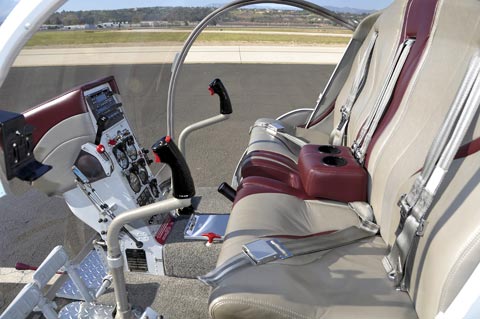
A little more power and the spritely 47 came off the ground, which is when I began to feel as though I were trying to stand and balance myself atop a greased beach ball. After a while, though, some of my ancient helicopter skills began to return, and I could hover over a spot (a very large spot!) without an imminent sense of crashing, but it was not pretty.
I then pulled up on the collective a bit more (while concurrently adding throttle), pushed forward slightly on the stick, and accelerated to a climb speed of about 50 mph.
At altitude, Obi had me do some maneuvering and then asked me to hover at altitude. This takes a lot more power than it does when hovering in ground effect. He then asked me to settle with power. This means allowing the helicopter to descend at zero airspeed into its own rotor wash at a sink rate of at least 300 fpm. The beleaguered 47 began to shake and buffet almost the way an airplane does when held in a stall. Recovery is similar, too—just lower the nose and pick up forward speed to escape the downwash.
Next came autorotation. Obi twisted off the power, and I immediately lowered the collective. Holding up the collective without power would result in losing needed rotor speed, and the helicopter would begin falling like a stone instead of gliding.
I was grateful for being in a Bell 47 because it has high-inertia (heavy) rotor blades. It is more difficult to lose rotor rpm in a 47 than when flying other small helicopters with lighter blades.
The flip side of this coin, however, is that if you do get sloppy and allow rotor speed to decay below limits, it is more difficult to recover lost rpm.
Helicopter pilots are supposed to manipulate the cyclic control with their fingertips. Only light control movements are required to fly a helicopter well. At the end of my first flight, though, my hands were dripping with sweat. Restoring proficiency will require practice—lots of it.
In December 2009, Scott’s Helicopter Service in Le Sueur, Minnesota, purchased the type certificates and tooling for the venerable Bell 47 from Bell Helicopter and formed Scott’s Bell 47.
The new company is now responsible for providing technical support for the Bell 47 and will be manufacturing replacement parts. Its long-term goal is to obtain a production certificate from the FAA and begin manufacturing certain models of what will be called Scott’s Bell 47.
